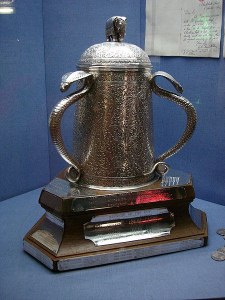The Calcutta Cup is the trophy presented to the winner of the England versus Scotland rugby union match which takes place during the annual Six Nations Championship – also currently known as the Guiness Six Nations – between England, Scotland, Wales, Ireland, France and Italy.
The Six Nations Championships date back to 1883 in its original guise as the Home Nations Championships, when it was contested by England, Ireland, Scotland and Wales. More recently, trophies have been awarded for a number of individual competitions during the Six Nations including the Millennium Trophy which is awarded to the winner of the game between England and Ireland; the Giuseppe Garibaldi Trophy which is awarded to the winner of the game between France and Italy, and the Centenary Quaich which is awarded to the winner of the game between Scotland and Ireland. A “Quaich” is a shallow two-handled Scottish Gaelic drinking cup or bowl.
However, the Calcutta Cup pre-dates all of the other Six Nations trophies and indeed the competition itself.

England v. Scotland, 1901
Following the popular introduction of rugby to India in 1872, the Calcutta (Rugby) Football Club was established by former students of Rugby School in January 1873, joining the Rugby Football Union in 1874. However, with the departure of a local British army regiment (and perhaps more crucially the cancellation of the free bar at the club!), interest in rugby diminished in the area and sports such as cricket, tennis and polo began to thrive as they were better suited to the Indian climate.
Whilst the Calcutta (Rugby) Football Club was disbanded in 1878, members decided to keep the memory of the club alive by having the remaining 270 silver rupees in their bank account melted down to be made into a trophy. The trophy was then presented to the Rugby Football Union (RFU) to be used as “the best means of doing some lasting good for the cause of Rugby Football.”
The trophy, which stands at approximately 18 inches (45 cm) high, sits on a wooden base whose plates hold the date of each match played; the winning country and the names of both team captains. The silver cup is delicately etched and decorated with three king cobras who form the handles of the cup and sitting atop the circular lid is an Indian elephant.

The Calcutta Cup on display at Twickenham, 2007
The original trophy is still in existence but years of mistreatment (including a drunken kick about in 1988 on Princes Street in Edinburgh by the England player Dean Richards and the Scottish player John Jeffry in which the trophy was used as the ball) have left it too fragile to be moved from its permanent home at the Museum of Rugby in Twickenham. Instead both England and Scotland have full size models of the cup to be displayed by the winning team and when England are the victors the original trophy is displayed by the Museum of Rugby in a purpose built trophy cabinet with revolving stand.
The Calcutta Club had thought that the trophy would be used as an annual prize for club competitions, similarly to the Football FA Cup which was introduced around the same time. Indeed in 1884 the Calcutta Cricket and Football Club re-established rugby in Calcutta in 1884 and a club trophy called the Calcutta Rugby Union Challenge Cup – which also became known as the Calcutta Cup – was introduced in 1890. However, the RFU preferred to keep the competition at international level to retain the ‘gentlemanly’ rather than competitive nature of the sport and run the risk of a move to professionalism.

England rugby captain Martin Johnson signing autographs on the Close
at the birthplace of rugby football, Rugby School
As Wales didn’t have a national team and Ireland’s team lagged far behind the English and Scottish sides, the Calcutta Cup became the victor’s trophy in the annual England versus Scotland game following its arrival in the UK in 1878. Since the first game in 1879 (which was declared a draw) England has won 72 of the 132 matches played and Scotland 44, with remainder of matches ending in a draw between the two sides. Annual matches between the two sides have continued every year since, with the exception of the World War years between 1915-1919 and 1940-1946. The venue for the match is always the Murrayfield Stadium in Scotland, since 1925, during even years and the Twickenham Stadium in England, since 1911, during odd years.
With the introduction of the Home Nations competition in 1883 and the vast improvement in the Irish and Welsh sides it was suggested that the Calcutta Cup went to the winner of the Home Nations competition. However, the tradition of the trophy going to the victors of the England versus Scotland game was a popular one and the suggestion was overruled.
In 2025, at the 132nd meeting of the two countries, after a scappy game and certainly not one for the purists, Scotland’s four year hold of the Calcutta Cup came to an end. Although Duhan van der Merwe, Scotland’s flying winger, once again secured the Man-of-the-Match award.
First Published: May 1, 2016.
Edited: February 22, 2025.







